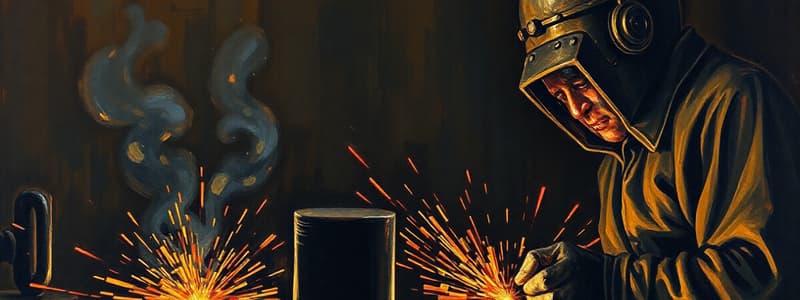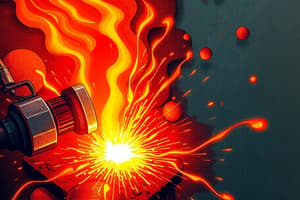Podcast
Questions and Answers
Which type of welding involves melting the two parts to be joined?
Which type of welding involves melting the two parts to be joined?
- Resistance welding
- Arc welding
- Solid-state welding
- Fusion welding (correct)
What is added in many fusion welding operations to enhance the joint's strength?
What is added in many fusion welding operations to enhance the joint's strength?
- Powdered metal
- Filler metal (correct)
- Flux
- Gas
Which type of welding does not involve melting the base metals?
Which type of welding does not involve melting the base metals?
- Arc welding
- Resistance welding
- Solid-state welding (correct)
- Oxyfuel gas welding
What is the primary mechanism used in resistance welding to achieve coalescence?
What is the primary mechanism used in resistance welding to achieve coalescence?
Which welding process is classified as arc welding?
Which welding process is classified as arc welding?
An autogenous weld is characterized by which of the following?
An autogenous weld is characterized by which of the following?
Which group categorizes the majority of welding processes available?
Which group categorizes the majority of welding processes available?
What type of welding process uses heat from burning gases?
What type of welding process uses heat from burning gases?
What is the primary function of oxyfuel gas in welding processes?
What is the primary function of oxyfuel gas in welding processes?
Which of the following processes is not a solid-state welding method?
Which of the following processes is not a solid-state welding method?
What temperature condition is characteristic of solid-state welding when heat is used?
What temperature condition is characteristic of solid-state welding when heat is used?
Which of the following is a primary application of welding?
Which of the following is a primary application of welding?
What does the term 'joining' encompass?
What does the term 'joining' encompass?
What defines the role of a welder in manual welding operations?
What defines the role of a welder in manual welding operations?
What is a characteristic of the welded joint compared to the parent materials?
What is a characteristic of the welded joint compared to the parent materials?
Which welding method utilizes ultrasonic frequencies for joining parts?
Which welding method utilizes ultrasonic frequencies for joining parts?
What is one advantage of welding over mechanical assembly methods?
What is one advantage of welding over mechanical assembly methods?
In what types of locations can welding operations typically be performed?
In what types of locations can welding operations typically be performed?
Which of these statements about welding processes is true?
Which of these statements about welding processes is true?
What is the purpose of applying pressure in solid-state welding?
What is the purpose of applying pressure in solid-state welding?
What is a drawback of welding as an assembly method?
What is a drawback of welding as an assembly method?
In what situation should welding not be used as an assembly method?
In what situation should welding not be used as an assembly method?
What does the term 'weldment' refer to?
What does the term 'weldment' refer to?
Which statement is true concerning manual welding operations?
Which statement is true concerning manual welding operations?
Flashcards
Welding
Welding
A joining process that uses heat and/or pressure to unite two or more parts into a single, permanent structure.
Weldment
Weldment
The assembled structure formed by welding.
Joining
Joining
Creating a permanent bond between parts.
Assembly
Assembly
Signup and view all the flashcards
Filler Metal
Filler Metal
Signup and view all the flashcards
Welding Limitation (Expense)
Welding Limitation (Expense)
Signup and view all the flashcards
Welding Limitation (Disassembly)
Welding Limitation (Disassembly)
Signup and view all the flashcards
Welding Limitation (Safety)
Welding Limitation (Safety)
Signup and view all the flashcards
Faye Surfaces
Faye Surfaces
Signup and view all the flashcards
Fusion Welding
Fusion Welding
Signup and view all the flashcards
Solid-State Welding
Solid-State Welding
Signup and view all the flashcards
Arc Welding (AW)
Arc Welding (AW)
Signup and view all the flashcards
Resistance Welding (RW)
Resistance Welding (RW)
Signup and view all the flashcards
Oxyfuel Gas Welding (OFW)
Oxyfuel Gas Welding (OFW)
Signup and view all the flashcards
Autogenous Weld
Autogenous Weld
Signup and view all the flashcards
Oxyfuel Welding
Oxyfuel Welding
Signup and view all the flashcards
Electron-Beam Welding
Electron-Beam Welding
Signup and view all the flashcards
Laser-Beam Welding
Laser-Beam Welding
Signup and view all the flashcards
Diffusion Welding (DFW)
Diffusion Welding (DFW)
Signup and view all the flashcards
Friction Welding (FRW)
Friction Welding (FRW)
Signup and view all the flashcards
Ultrasonic Welding (USW)
Ultrasonic Welding (USW)
Signup and view all the flashcards
Welding Applications
Welding Applications
Signup and view all the flashcards
Study Notes
Fundamentals of Welding
- Welding is a joining process coalescing parts via heat and/or pressure.
- It creates permanent joints, unlike some assembly methods.
- The combined components are called weldments.
- Welding is used for metals and plastics.
- Welded joints can be stronger than the original materials.
- Often uses filler metal to enhance strength.
- Welding is often the most cost-effective method.
- Welding is not limited to factories; field work is possible.
Welding Drawbacks
- Welding operations are often labor-intensive and expensive.
- Welding is a skilled trade; labor can be scarce.
- Permanent bonds make disassembly difficult.
- Quality defects that hinder strength are possible.
- Defects are challenging to detect.
Welding Process Types
- Welding is categorized into fusion and solid-state welding.
- Fusion welding involves melting the base materials, sometimes using filler metals.
- Solid-state welding uses pressure, sometimes along with heat, to join metals below their melting point.
- Fusion welding is more prominent.
Types of Fusion Welding
- Common subcategories include arc welding, resistance welding, oxyfuel gas welding, and others.
Welding Applications
- Welding is used in a variety of industries for structural elements, pipelines, pressure vessels, and transports (aircraft, automobiles).
- Welding is used in construction, shipbuilding, and aerospace applications.
- Often used in factory settings and in-place construction situations.
- Welding operations are generally labor-intensive and necessitate skilled labor.
Studying That Suits You
Use AI to generate personalized quizzes and flashcards to suit your learning preferences.




